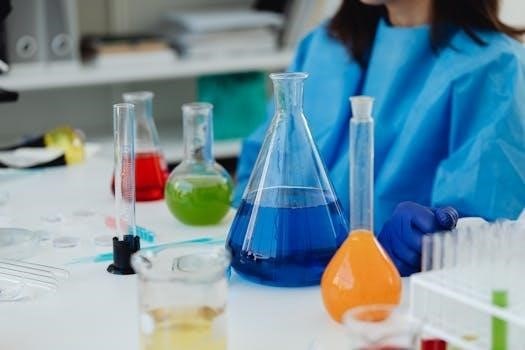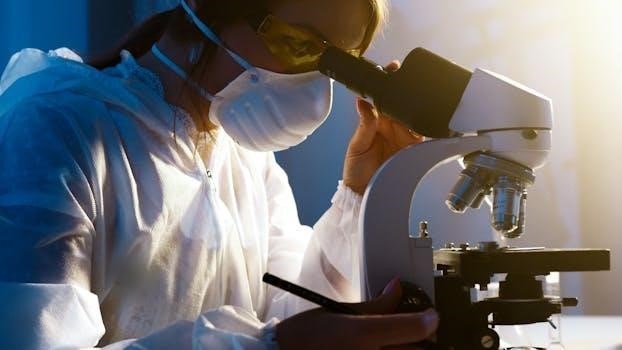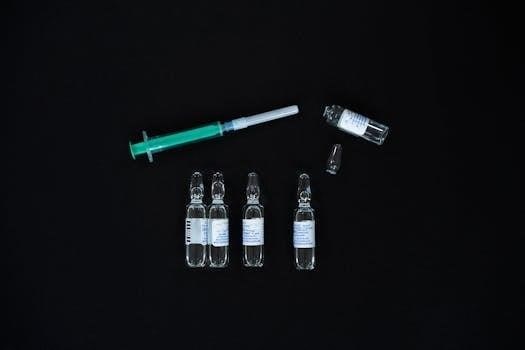Lab safety worksheets are crucial educational tools. They help students understand the importance of proper lab procedures. These worksheets often include answer keys which provide explanations and examples. This ensures a thorough understanding of safety practices. The worksheets are essential for learning basic rules.
Importance of Lab Safety Education
Lab safety education is paramount to ensuring a secure learning environment. It teaches students to identify potential hazards and how to respond. Understanding lab safety minimizes the risk of accidents and injuries. Proper training helps students become responsible and conscientious in a laboratory setting. It promotes a culture of safety. This involves knowing how to use equipment correctly and follow procedures. Lab safety education also emphasizes the importance of respecting chemicals and materials. Moreover, it teaches the proper disposal of waste. Educating students about lab safety from the beginning is essential. It helps them develop safe work habits, essential for both school and future careers. These practices are not just for school labs but for any professional lab setting. Ultimately, it is about protecting students and fostering a safe environment. The use of worksheets and answer keys in this education provides a clear, effective way to learn and review the key concepts. It is important for all students to engage in this type of education.

Essential Lab Safety Equipment
Proper lab safety equipment is crucial for preventing injuries. This includes items like safety goggles for eye protection. Other equipment includes gloves and appropriate clothing. Knowing their purpose ensures a safe lab experience.
Eye Protection⁚ Safety Goggles
Safety goggles are indispensable for laboratory work, providing critical protection against potential hazards. They shield eyes from chemical splashes, projectile debris, and harmful vapors, all common risks in a lab environment. Wearing safety goggles is not optional; it is a mandatory safety measure that should be strictly adhered to at all times during experiments or procedures. These goggles should fit securely to ensure comprehensive coverage and prevent any gaps through which substances might enter. It’s vital to inspect goggles before use for any damage or scratches that could compromise their effectiveness. Proper usage and maintenance of safety goggles are essential components of responsible lab practice. Remember, protecting your eyes is paramount to ensuring a safe experience. Always confirm that you have the appropriate eye protection for the task at hand and never proceed without it. The answer key often emphasizes correct usage.
Prohibited Items⁚ Food and Gum
Consuming food or chewing gum in a laboratory setting is strictly prohibited due to significant safety concerns. These items can easily become contaminated with hazardous chemicals, making them a potential source of ingestion-related health problems. Furthermore, eating or chewing in the lab distracts from focusing on experiments and can lead to accidental spills or contact with dangerous substances. The lab environment is designed for scientific activities, not for eating; therefore, bringing food or gum into the area introduces unnecessary risk. Adhering to this rule is crucial for maintaining a safe and controlled space. The answer keys in worksheets often highlight this rule, emphasizing that it is a non-negotiable aspect of lab safety protocol. Remember, labs are not a place for snacks; they are a place for careful work. Always prioritize safety over personal convenience and never consume anything in the lab.

Emergency Procedures
Knowing emergency procedures is vital for lab safety. This includes identifying evacuation routes during a fire. Worksheets often contain this information, along with answer keys that help students understand the appropriate actions.
Evacuation Routes in Case of Fire
Understanding evacuation routes is a critical component of lab safety, particularly when dealing with potential fire hazards. Lab safety worksheets often include specific instructions on how to locate and follow designated escape paths. These routes are designed to ensure the safe and orderly exit of all personnel during an emergency. The answer keys accompanying these worksheets provide detailed explanations, clarifying the importance of each step. Familiarity with these routes can significantly reduce panic and confusion in a real emergency. Worksheets might also include diagrams or visual aids to further enhance comprehension of evacuation procedures. It’s crucial for students to review these plans carefully and understand their role in ensuring safety. The answer keys serve not only as a guide for correct answers, but also as a tool to reinforce the necessity of prompt and efficient responses during fire emergencies.
Key Lab Safety Concepts
Key lab safety concepts involve understanding hazardous materials, proper disposal, and safe practices. Worksheets often assess knowledge of these concepts. Answer keys provide correct information and explanations for all safety protocols and procedures.
Identifying Unsafe Activities in Lab Settings
Recognizing unsafe activities is paramount for lab safety. Worksheets often present scenarios or illustrations depicting students engaging in risky behaviors. These might include not wearing safety goggles, consuming food or gum, or improper handling of chemicals. The goal is for students to identify these violations and understand their potential consequences. For instance, a worksheet might show a student mixing chemicals without proper ventilation. The answer key would clarify why this is unsafe, and what steps to take to ensure safety. This also includes understanding proper techniques for transferring liquids and avoiding habits such as putting hands in mouths or eyes during experiments. The worksheets also emphasize the importance of reading and understanding Material Safety Data Sheets (MSDS) to be aware of chemical hazards. Identifying these unsafe behaviors is a critical skill that helps prevent accidents and promote a culture of safety.
Proper Disposal of Chemical Waste
Proper disposal of chemical waste is a crucial aspect of lab safety. Worksheets often cover this topic, emphasizing that chemicals should never be mixed in sink drains. Sinks are primarily for water and designated solutions, not for chemical disposal. Answer keys explain the importance of separating waste into appropriate containers. These containers are often labeled for specific types of chemicals, such as acids, bases, or organic solvents. The worksheets also highlight the risks of improper disposal, such as environmental contamination and potential hazards to personnel. They provide guidance on how to handle different types of waste, including solids and liquids. They also cover how to treat specific solutions. Furthermore, these materials teach students to avoid bad habits like putting hands in their eyes or mouths. Worksheets also emphasize the need to follow all instructions in the lab. This is a critical skill for ensuring both personal and environmental safety.

Worksheet Components
Lab safety worksheets include a review of key terms and concepts. They also present scenarios and questions to test comprehension. These components ensure students learn safety rules. They also promote practical application of knowledge.
Review of Terms and Concepts
This section of lab safety worksheets focuses on reinforcing understanding of essential terminology and core ideas. It is vital for students to grasp the meaning of specific safety terms before engaging in practical laboratory work. The review often includes definitions of hazard symbols, proper equipment usage, and emergency procedures. Students will encounter terms like “MSDS” which stands for Material Safety Data Sheet, and “PPE” referring to Personal Protective Equipment. Quizzes and matching exercises are common methods. These ensure students can correctly identify hazards and understand associated risks. A strong grasp of these terms is crucial for creating a safe working environment in the lab. This review acts as a foundation before addressing more intricate scenarios in the worksheets. This reinforces the student’s knowledge. A thorough understanding of these terms is important. This is key to ensuring a safe laboratory.
Scenarios and Questions on Lab Safety
This section of the worksheet presents students with various real-world lab scenarios. These situations challenge students to apply their knowledge of safety rules. Each scenario typically includes a question asking the student to identify potential risks or suggest safe practices. Questions may involve interpreting situations depicted in cartoons or photos. They could also ask students to explain correct actions based on a written description of a lab activity. For example, a scenario may show a student not wearing safety goggles. Students then need to explain why it is unsafe and what should be done. These questions help to move past memorization. Students can use their understanding of lab safety. The scenarios in this section promote critical thinking. They reinforce the use of safety procedures. This is to prepare students for actual laboratory work. The answer key provided will help in understanding.

Additional Resources
This section will guide you to find further help. This includes worksheets with answer keys and online quizzes. These tools will enhance your lab safety knowledge. They can be found online on various educational websites.
Where to Find Lab Safety Worksheets and Answer Keys
Locating lab safety worksheets and their corresponding answer keys is quite straightforward with a bit of online searching. Many educational websites, such as Teachers Pay Teachers, offer a variety of free and paid resources. These resources range from simple review sheets to more complex scenario-based worksheets. Flinn Scientific, a well-known supplier of science equipment, also provides safety materials and worksheets. Additionally, numerous websites that offer educational content often include lab safety worksheets and answer keys. When searching, using specific keywords like “lab safety worksheet answer key pdf” can yield more relevant results. Remember to verify the source of the worksheet to ensure its accuracy and suitability for the desired level of learning. Always prioritize resources that are aligned with current safety standards and educational guidelines for optimal learning.
Online Tools and Quizzes for Lab Safety
The digital realm offers a wide array of online tools and quizzes designed to reinforce lab safety knowledge. Platforms like Quizlet provide interactive flashcards, games, and quizzes. These resources are invaluable for students to engage with safety rules in an enjoyable manner. Many educational websites also host online quizzes, which can provide immediate feedback on student comprehension of lab protocols. Some online tools may offer features like progress tracking and personalized learning paths. These features help to tailor the learning experience to individual needs. Course Hero and similar platforms often provide access to study materials including lecture notes, summaries, and quizzes. These tools can be useful to supplement traditional lab safety worksheets. Furthermore, some websites offer virtual lab simulations, which allow students to practice safety procedures in a risk-free environment. These online tools make learning lab safety more dynamic and engaging.
